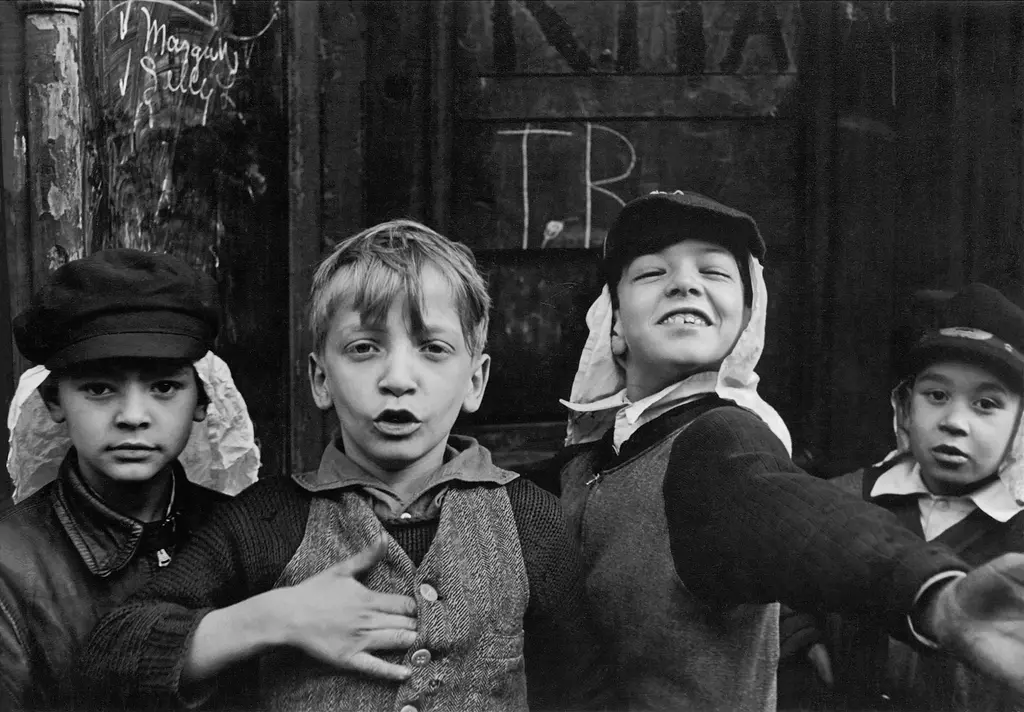Helen Levitt’s intimate scenes of 20th century New York life
- Text by Miss Rosen
- Photography by Helen Levitt

Hailing from Bensonhurst, Brooklyn, Helen Levitt (1913–2009) was a New York original. The daughter of Russian Jewish émigrés, Levitt rose to become one the greatest street photographers of the 20th century.
“In a genre dominated by men at the time, Levitt created an outstanding body of work that spans more than six decades and encompasses images, films and books,” says Anna Dannemann, Senior Curator at The Photographers’ Gallery, who collaborated with curator Walter Moser and the Albertina Museum in Vienna, on the new exhibition, Helen Levitt: In the Street.
The exhibition, along with the new book Helen Levitt, offer a look at street life in working-class communities around New York, which she began photographing in 1936 after meeting Henri Cartier-Bresson. Drawn to the spectacle of everyday life, Levitt embraced the passion and pathos of the community — a time when kids transformed the streets into their playground.

New York, 1978, © Film Documents LLC, courtesy Galerie Thomas Zander, Cologne
“Levitt’s photographs are spellbinding, full of real events that appear as almost more present and larger than life,” says Dannemann. “Her images don’t follow the rules of documentary photography but instead focus on emotions, happenstances and irrationalities.”
Drawing inspiration from Cartier-Bresson, Walker Evans, avant-garde cinema, social realism, and slapstick comedies, Levitt’s work is poetic in the truest sense of the word. “Her images thrive through contradictions, a complexity that allows for differences to exist simultaneously,” Dannemann observes.

New York, 1973 © Film Documents LLC, courtesy Galerie Thomas Zander, Cologne

New York, 1940 © Film Documents LLC, courtesy Galerie Thomas Zander, Cologne
When photographing adults, Levitt delights in depicting them liberated from the confines of polite society, creating powerful psychological portraits infused with empathy. Levitt manages to find expressions of her subject’s inner child through unexpected moments of release.
Although less famous than her contemporaries, Levitt was able to establish a career working as both a photographer and later a cinematographer. From 1945 to 1966, Levitt partnered with filmmaker Janice Loeb and writer James Agee to create In the Street.
Shot on the streets of Spanish Harlem, the ten-minute experimental documentary film is considered a key precursor to the cinéma vérité of the 1960s. Composed of a series of brief sequences without narration or soundtrack, the film is a pure, cinematic expansion of life inside Levitt’s photographs.

New York, 1971 © Film Documents LLC, courtesy Galerie Thomas Zander, Cologne
It opens with a written prologue by Agee, which gives voice to Levitt’s vision: “The streets of the poor quarters of great cities are, above all, a theatre and a battleground. There, unaware and unnoticed, every human being is a poet, a masker, a warrior, a dancer and in his innocent artistry he projects, against the turmoil of the street, an image of human existence.”
Offering a window into a world that largely no longer exists, Levitt’s work continues to resonate decades after it was made. “They show what I would describe as deeply human,” says Dannemann.
“The children’s play in the streets reminds us of a freedom from norms, constraints, and the capitalist system. There is something to be learned from observing these interactions and games on the street, and Helen Levitt lets the rest of us in on it.”

New York, 1980 © Film Documents LLC, courtesy Galerie Thomas Zander, Cologne

New York, 1938, © Film Documents LLC, courtesy Galerie Thomas Zander, Cologne

New York, 1982, © Film Documents LLC courtesy Galerie Thomas Zander, Cologne

New York, ca. 1945 © Film Documents LLC, courtesy Galerie Thomas Zander, Cologne
Helen Levitt: In the Street is on view at The Photographers’ Gallery, London from October 15, 2021 – February 13, 2022.
Enjoyed this article? Like Huck on Facebook or follow us on Twitter and Instagram.
Latest on Huck

Bernie Sanders introduces Clairo at Coachella, urging young Americans to “stand up for justice”
Coachella charmed — The Vermont Senator praised the singer-songwriter for her efforts in raising awareness of women’s rights issues and Gaza.
Written by: Isaac Muk

The Changing Face Of Brooklyn, New York’s Most Colourful Borough
After three decades spent capturing stories around the world, Magnum Photographer Alex Webb finally decided to return home to Brooklyn – a place that champions chaos, diversity and community spirit.
Written by: Alex Webb / Magnum Photos

The mundane bliss of New York’s subways in the ’70s
NYC Passengers 1976-1981 — During a very different decade in NYC, which bounced between rich creativity and sketchiness, photographer Joni Sternbach captured the idiosyncratic isolation found on its rail networks.
Written by: Miss Rosen

Analogue Appreciation: lullahush
Ithaca — In an ever more digital, online world, we ask our favourite artists about their most cherished pieces of physical culture. Today, it’s Irish retro-futurist lullahush.
Written by: lullahush

Spyros Rennt captures connection and tenderness among Berlin’s queer youth
Intertwined — In the Greek photographer’s fourth photobook, he lays out spreads of togetherness among his friends and the German capital’s LGBTQ+ party scene.
Written by: Isaac Muk

The rebellious roots of Cornwall’s surfing scene
100 years of waveriding — Despite past attempts to ban the sport from beaches, surfers have remained as integral, conservationist presences in England’s southwestern tip. A new exhibition in Falmouth traces its long history in the area.
Written by: Ella Glossop